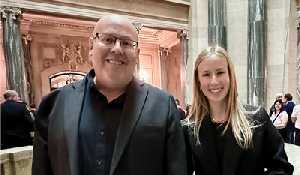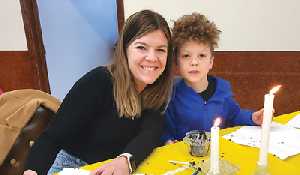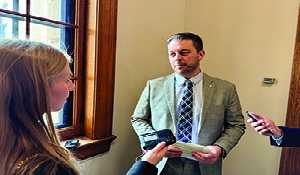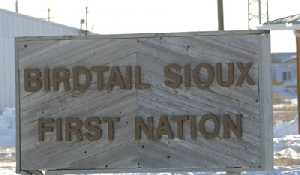Seed Hawk now Vaderstad: New name, new CEO for company
November 7, 2017, 1:43 am
Kevin Weedmark
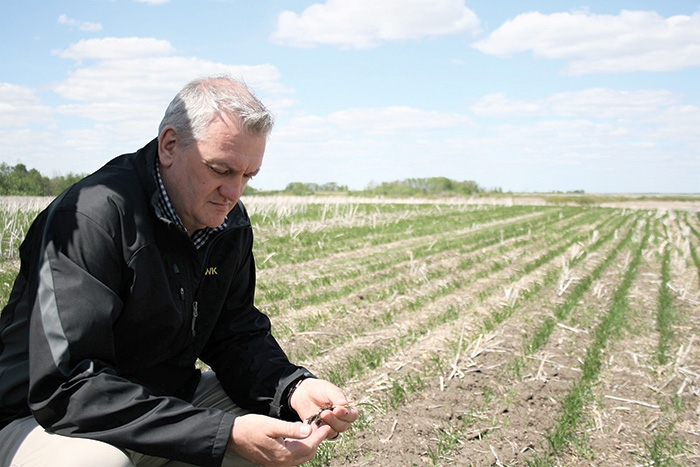

There have been a lot of changes at Langbank’s Seed Hawk air seeder manufacturing plant, with a new CEO taking the helm in late October, and the company taking on the name of its parent company, Vaderstad, as of Oct. 31.
The company continues to grow, with current hiring that will add five to 10 per cent to the workforce of 150.
Nigel Jones is the new Chief Executive Officer of the company. He has been with the company for three years and had served as the Vice President of Operations since he was hired, and took on the additional role of Vice President of R&D in December 2016.
He says the name change helps integrate Seed Hawk into the parent company.
“It integrates us into the overall global business from a Vaderstad point of view,” he explains. “The intent is that we end up with manufacturing groups that mirror each other both in Sweden and here, and the intent is the Seed Hawk name doesn’t go away—it becomes a brand in its own right. The company name has changed to integrate, but the brand remains part of the house of brands so we end up with the Seed Hawk and also at the Vaderstad corporate level we have the Carrier, Tempo, Rapid and Spirit, and Seed Hawk sits alongside those now.”
The Seed Hawk plant has been part of Langbank for a quarter century.
“Seed Hawk has been around for 25 years as of this year,” Jones explains. “It started out with Pat Beaujot. He and his brother identified a gap in the market for an opener which would have a multi purpose so they could plant seed in a very shallow position to give the seed the best chance of germination, and they came up with an opener that they thought would give them the shallow seed placement, the accuracy placement in one pass so they don’t have to till prior to seeding, and that is where it got born.”
“Over the years it has been the opener which is the main technology. It is a great tool in terms of the seed placement and germination and that is what the business grew up around.
“Over the years there have been a number of developments including the sectional control technology which allows sectional control—where you are putting seed, where you’re not putting seed, and that was the next great innovation. Vaderstad got interested around ten years ago in 2006 or 2007. They were looking at an opportunity to break into the North American market and they saw some tremendous synergies and similarities between the two companies.
“Seed Hawk grew from a gap in the market, an entrepreneurial vision and a startup in a shed or a small shop. Vaderstad grew up the same way, only they have been around for 50 years now. All along that time span they grew up the same way, so there were a lot of synergies and similarities in terms of the entrepreneurial nature of the business. They thought it was a good fit for them to break into the North American market, so they bought a non-controlling stake in the business, and over a period of four to five years or so they wanted to expand that presence in North America and there were some thoughts about maybe starting a facility of their own, which then transferred to why not own all of Seed Hawk because Seed Hawk wanted to exploit the Vaderstad presence in Europe as well. So it was a win-win for both sides. It also provided a vehicle for Seed Hawk to grow as a global brand. So that is how Vaderstad ended up with full ownership.”
Vaderstad invested in the Seed Hawk operation, and both the footprint of the plant and the staff grew.
“Right now we’re around the 150 mark at Langbank. We have grown from just a few people in the shop. It started out as three couples—husbands and wives—and now it is a 150 person business and we are looking to expand on that at the moment.
“We are looking at more recruitment; we are actively recruiting right now. You will see a small five to 10 per cent increase in the staff over the next three months. We do have a full order book right through to March so we are flat out at the moment in terms of capacity.” roksa.ch
What is the next phase of expansion?
“The next phase for us is to look at other markets again. We are now looking at the U.S. market seriously and we are looking at the European market again because over the last year or so we have been getting some interest particularly in Spain, France and some of the western Europe countries. We also have an opportunity for some of the big equipment in eastern Europe again. Those are the markets we are looking to move into.
“Similarly we have an opportunity with our parent company in terms of some of their products maybe not manufacturing here, but certainly distributing here. That business has been growing fairly consistently in eastern Canada at the moment and we are looking to move more into the west and exploit some of those products.”
The Seed Hawk seeder will continue to carry that name and the marketing network will remain the same.
Vaderstad is making a major move into North America with its high speed, precision planter technology. Most of its machines, such as the Tempo planter and vertical tillage tools, are destined for the American corn belt.
This spring in Hungary a 16-row Vaderstad Tempo corn planter set a new world record putting down 1,240 acres in 24 hours, breaking the old record of 1,108 acres set with a 24-row planter.
Born and raised in South Wales in the UK, Jones relocated to Canada in 2006 with his wife and two daughters.
“I joined Seed Hawk in November of 2014. I joined as the VP of operations,” he explains. “Over that two-year period we worked a lot on the processes and systems here to be able to strengthen the company. My background is in the automotive industry, so I was to bring a bit of structure and some process to the table.
“I started out as a tool maker, a mechanical engineer a long time ago and I worked in various functions throughout my career, ranging from engineering quality and production management and general management. In December 2016 I assumed the R & D position as well. I gained more experience with building process and establishing relationships with the parent company, to start building those collaborations. We are very keen to exploit the expertise from Vaderstad and use that to our benefit, so there is some collaboration certainly with the engineering department and we are looking to expand that a little bit further.”
The engineering for the Seed Hawk products is all done in Langbank.
“It is all done in Langbank and we own the design through manufacturing and distribution,” says Jones. “We did collaborate recently with Sweden on the Phoenix meter update that we did in model year 2016. We collaborated heavily with them. We used a product that Väderstad was developing. That was the first big collaboration.”
How big an adjustment is the move into the CEO role?
“It has happened so quickly I didn’t really have time to think about it,” says Jones. “You just get on with it. The real adjustment is to extend the scope a little bit in terms of the nature of the role. The first level operations and looking after the day to day operations of the whole company is not much of a stretch because I looked after 70 percent of it anyway. Where the adjustment starts to come in is now I am looking at making sure that from a vision and from a direction point of view the company stays on the strategic path. The third element, which is a new element entirely, is the connection to the board. That connection between the business as it is and the board as it is, that is the new area. I get a chance to see that firsthand next week because it will be the first board meeting as the CEO that I sit on. It is all happening very quickly.”
From his new perch as CEO, what does the future look like for Vaderstad in Langbank?
“It looks very bright and it is very promising,” says Jones. “We’ve come off the back of a very strong seeding season. We have a full order book right through March and into April. We are no longer taking orders for model year 2018. We are at the point we are starting the launch for the model year 2019. I see great opportunities for us as we collaborate more with our Swedish partners.
“Our objective right now is to be recognized as the leading air seeder brand in North America on the basis of quality, innovation and customer focus, so I’m very optimistic and very excited for the future of the plant here.”
What are the challenges and advantages of operating a 150-person plant in a small community?
“The challenge is being able to attract and retain the staff that we need. It is a growth opportunity for us and it is quite a small catchment area. That poses one of the biggest challenges, especially when you are in an area which competes with oil patch, and with pipelines and potash. In terms of the benefits, generally the staff have a great affinity with the company because they are local. Because it is such a significant part of the community, you get a tremendous buy-in from people and it is encouraging to see when people working with the company associate with it, because everything is so closely knit. It is not like in the city where you can walk away from it and you don’t hear anything about work. It is intertwined with the community. So that is always a benefit when you have people that are interested in the company.”
How large is the local community Seed Hawk draws its employees from?
“Generally if you looked at a 30-40 minute catchment area that would be the main scope. We do have one or two that do travel a little bit further. Generally we are looking at anywhere between Moosomin, Whitewood, Wapella, Wawota, Kipling—in that zone.”
What goals does Jones hope to reach at Vaderstad?
“First of all is to stabilize the company. We’re coming off a couple of tough years in the field and in the market. One of the challenges and indicators will be that we can stabilize and can return to some fiscal stability.
“Another objective would be the growth. We have some fairly specific objectives in terms of being recognized as number one. Number one can mean different things to different people but we have some clear objectives in terms of growth. We want to achieve our growth number, and at the same time satisfy our shareholders at a fiscal point of view.
“There are four or five clear objectives there, and that will mark if I am successful or not.”






























